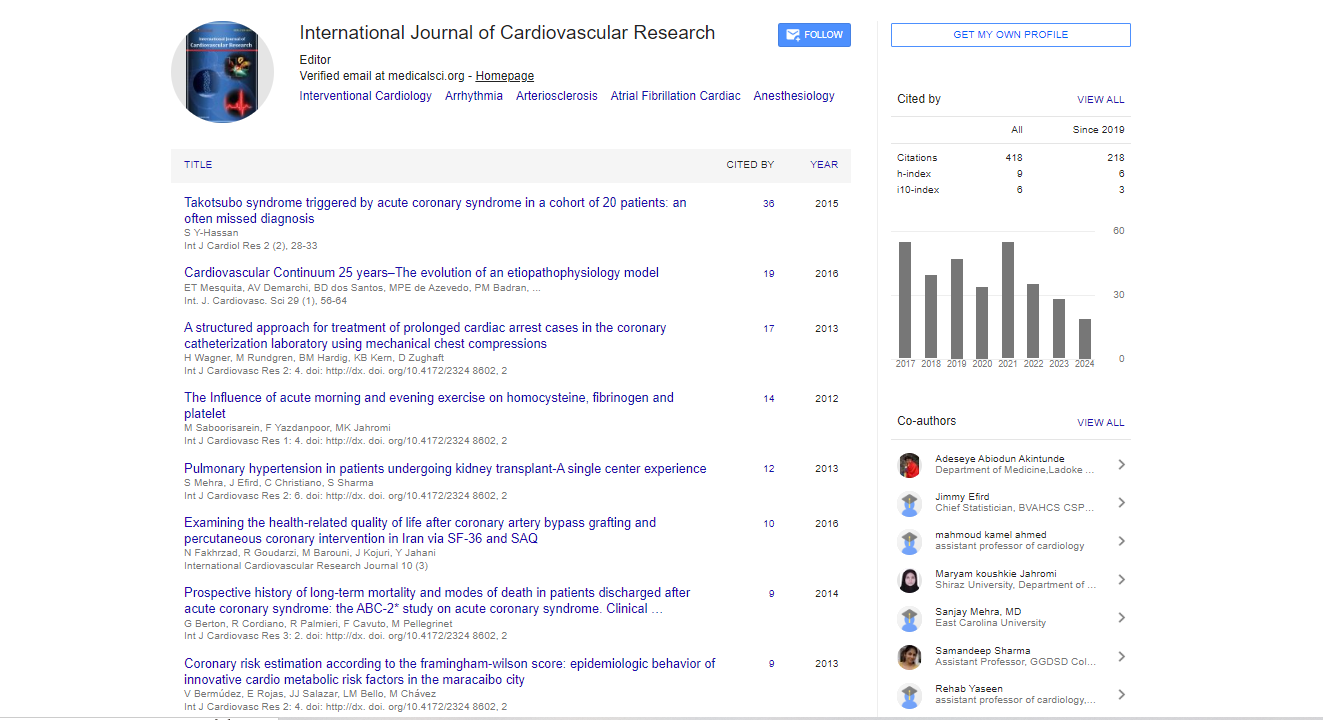Research Article, Int J Cardiovasc Res Vol: 4 Issue: 2
Collagen Metabolism Biomarkers and Health Related Quality of Life in Pulmonary Arterial Hypertension
| Zeenat Safdar1*, Emilio Tamez1, Adaani Frost1, Danielle Guffey2, Charles G Minard2 and Mark L Entman3 |
| 1Division of Pulmonary, Critical Care, and Sleep Medicine, Baylor College of Medicine, USA |
| 2Dan L Duncan Institute for Clinical and Translational Research, Baylor College of Medicine, USA |
| 3Division of Cardiology, Baylor College of Medicine, USA |
| Corresponding author : Zeenat Safdar, MD FACP, Associate Professor of Medicine, Baylor Pulmonary Hypertension Program, Baylor College of Medicine, Houston, Texas 77030, USA Tel: + 713 798 2400; Fax: 713 798 2688 E-mail: safdar@bcm.edu |
| Received: September 18, 2014 Accepted: January 23, 2015 Published: January 25, 2015 |
| Citation: Safdar Z, Tamez E, Frost A, Guffey D, Minard CG, et al. (2015) Collagen Metabolism Biomarkers and Health Related Quality of Life in Pulmonary Arterial Hypertension. Int J Cardiovasc Res 4:2. doi:10.4172/2324-8602.1000198 |
Abstract
Collagen Metabolism Biomarkers and Health Related Quality of Life in Pulmonary Arterial Hypertension
Objectives: The goal of this study was to investigate the association between collagen metabolism biomarkers and health related quality of life (HRQoL) in PAH patients. Methods: We prospectively enrolled 68 stable idiopathic, anorexigen-associated, and hereditary PAH subjects and 37 healthy controls. Serum samples were analyzed for N-terminal propeptide of type III procollagen (PIIINP), c-terminal telopeptide of collagen type I (CITP), matrix metalloproteinase 9 (MMP-9) and tissue inhibitor of metalloproteinase 1 (TIMP-1). The Minnesota Living with Heart Failure (MLWHF), EQ-5D (EQ-5D), Cambridge Pulmonary Hypertension Outcome Review (CAMPHOR) and Short Form (SF-36) general health survey were administered at the time of blood draw. General linear models, as well as logistic regression models were used to assess associations between variables. Results: CITP, PIIINP, MMP9, and TIMP1 levels, and all HRQoL domains were significantly different between controls and PAH patients (p<0.001 for each). Interestingly, PIIINP levels were significantly associated with MLWHF physical (coef=1.63, and p=0.02), SF-36 physical (coef=-2.93, p=0.004), and EQ-5D aggregate (coef=0.34, p=0.001) scores. Several of the CAMPHOR scores strongly linearly associated with PIIINP. The odds of obtaining a walk distance ≥330 meters decrease by 38% per unit increase in PIIINP (OR=0.62; 95% CI=0.43, 0.90) and a PIIINP cutoff of 5.53 μg/L provided 81% sensitivity and 82% specificity. Conclusions: PIIINP is the best predictor of disease severity, and is strongly related to HRQoL scores in PAH patients. These relationships suggest PIIINP as a promising tool for PAH clinicians to determine or confirm the level of disease severity.
 Spanish
Spanish  Chinese
Chinese  Russian
Russian  German
German  French
French  Japanese
Japanese  Portuguese
Portuguese  Hindi
Hindi 



